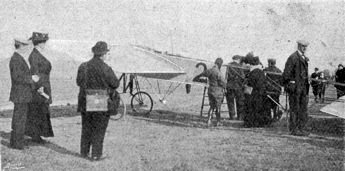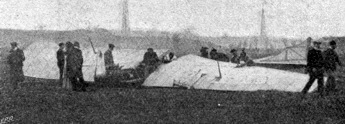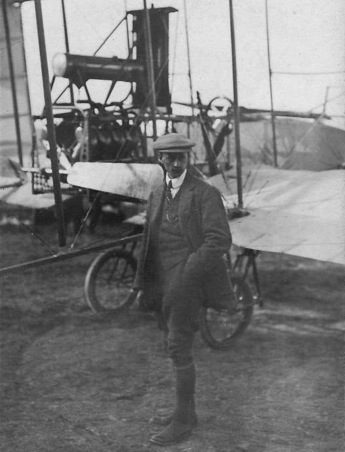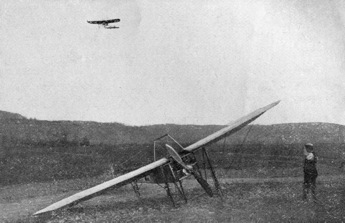Biarritz, France, March 27th - April 3rd, 1910
The start of the 1910 European season: A windy meeting on the west coast










Biarritz is a town on the Bay of Biscay in the Basque southwest
corner of France. In 1910 it had around 15,000 inhabitants and was a
popular health resort. Each year around 40,000 visitors came to enjoy
the mild coastal climate and the thermal and salt-water baths, which
were said to be particularly beneficial to persons suffering from
scrofula. Biarritz had been popular among nobility and royalty since
the days of Napoleon III.
In December 1908 the "Comité d'Aviation Bayonne-Biarritz"
was created at the initiative of Dr. Gallard, aide of the Mayor of
Biarritz. In early 1909 Louis Blériot was consulted on the construction
of an airfield, and as a consequence the committee decided to build an
airfield in the valley of the river Nive, some 6 km southeast of
Biarritz and at around the same distance south of the neighbouring town
Bayonne.
A limited company with a capital of 160,000 francs was formed, with
most of the money coming from the casinos of Biarritz. Messrs Salzedo
and Boulant were responsible for building the airfield, which according
to Flugsport was triangular, with sides of 1,200 m, 1,200 m and 1,500
m, and with a course that was 180 m wide. A special railway station was
planned and the airfield could also be reached by riverboats.
At a meeting on March 1st the program was finalized. The meeting would
be held between 27 March and 3 April, with competitions taking place on
29 and 30 March and 1-3 April. A total prize fund of 52,000 francs were
raised, with prizes for distance and altitude (both daily and overall),
cross-country flying, longest "vol plané" and flight in the
highest wind. The meeting was sanctioned by the Aéro-Club de France and
would be run according to FAI regulations.
The meeting was overshadowed by the bigger Cannes meeting, which was
held on the same days. Therefore the meeting was not covered in much
detail in the aviation press. We do for example not know of official
lists of entrants or results. The following is an effort to make sense
of the few reports that we have found.
This is a list of the participants mentioned in different reports:
- Capitaine Médéric Burgeat (Antoinette)
- Jorge Chávez (Farman)
- Arthur Duray (Farman)
- Alfred Leblanc (Blériot)
- Georges Leforestier (Garnier "Olga")
- Robert Mignot (Voisin)
- Gijs Küller (Antoinette)
- Marquis Luis de Salamanca (Nicolas)
Tuesday March 29th
King Edward VII of Britain, who was in bad health and was convalescing after a collapse a couple of weeks earlier, participated at the official opening of the meeting, together with colonel Arthur Davidson, lieutenant-colonel Holford, sir James Reid and a numerous entourage. This was one of last public appearances of the king, who would die less than six weeks later.He arrived shortly before four o'clock and went on a tour of the hangars. Then he was escorted to the honorary tribune by M. de Cartassac, a member of the committee.
The weather was perfect and Leblanc made three successful flights, to the applause of the public. Louis Blériot also flew a lap after having been asked by the king. The other participants were not lucky. Just before the arrival of the King, Chávez had problems steering his plane during his first takeoff and swerved into a tree stump that had been left inside the course when it had been cleared. The right wing was broken and parts of the propeller were thrown high in the air, but the pilot was unharmed and the plane was declared to be repairable.
Burgeat had engine problems and his first start failed. At around seven o'clock he then flew a lap before coming back to land, but he was too high and risked crashing into the hangars. Trying to avoid that, he cut the power brusquely and his planed dropped like a stone from around ten metres. The plane was almost completely wrecked, both wings were broken, but the captain escaped without injuries. The plane caught fire and the firemen had some difficulty extinguishing the flames. Leforestier had engine problems and couldn't make any flights.
Wednesday March 30th
Crowds were much smaller on the second day and the windy conditions made flying difficult. Mignot made two one-lap flights, but when landing after the second the wind drove him into an earth wall. The plane overturned and was badly damaged, but the pilot escaped with minor injuries. Despite an engine that didn't run well Leblanc made a flight of less than a lap around half past six. Not much flying in a whole day…
Thursday March 31st
Gale-force winds blew the whole day, which was anyway planned to be a flight-free day.
Friday April 1st
Leblanc took off at five o'clock and flew a lap and a half. Immediately afterwards he took off again and flew eight laps around the course, to the ovations of the crowd. He also made a third flight, this time only a single lap, but at an altitude of 65 metres. When he had landed Duray tried twice to take off, but only managed a short jump.
Saturday April 2nd
At four o'clock Leblanc made a flight of eight minutes. Chávez had repaired his plane and made a flight of 55 minutes, first climbing to 300 metres (or 310 or 450, depending on which report you trust!) and completing around ten laps at that altitude, then descending to almost ground level before climbing to 200 metres again. In total he covered some 45 kilometres, before making a superb landing. Duray flew two laps at a height of three metres. Leforestier's engine still refused to cooperate.
Sunday April 3rd
The wind and the waterlogged airfield discouraged most of the flyers, but at half past six Leblanc flew a lap despite the windy conditions, making a safe landing in front of the crowd, who finally got something to cheer about.
Leblanc, Chávez and Leforestier promised to fly on the following day if weather permitted, but there are no reports of any flights, so it probably didn't...
Conclusion
Even though the prize money wasn't insignificant, the Biarritz meeting was a minor meeting that attracted only a few competent flyers. Given the windy conditions on several days and the crashes that put half of the likely flying machines out of action it's natural that not very much was achieved.
The airfield was praised in the reports, but the somewhat chauvinistic reporter from "The Aero" had scathing criticism of the general organization ("a more haphazard state of affairs never could elsewhere exist"), the access roads ("of this road I have no words fit to use here") and "the high-priced useless boxes and seats".
Nevertheless, a second meeting was planned already for the second half of August.
